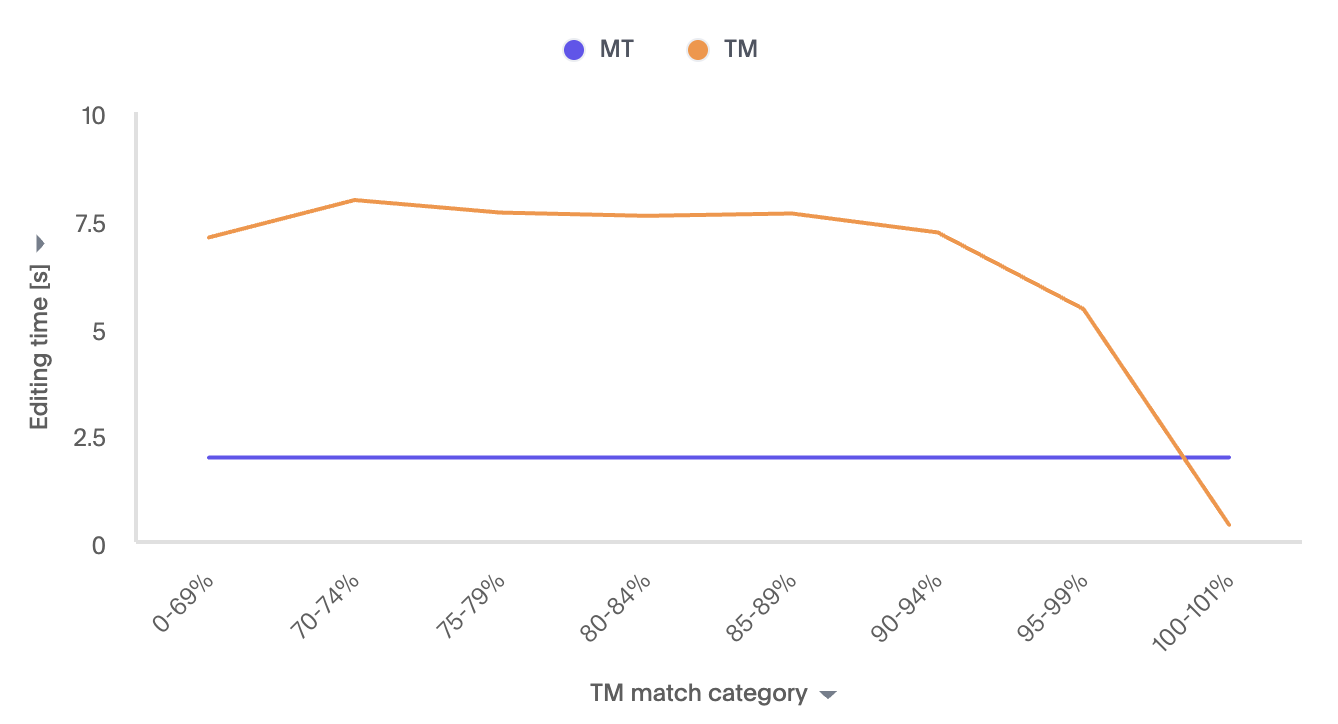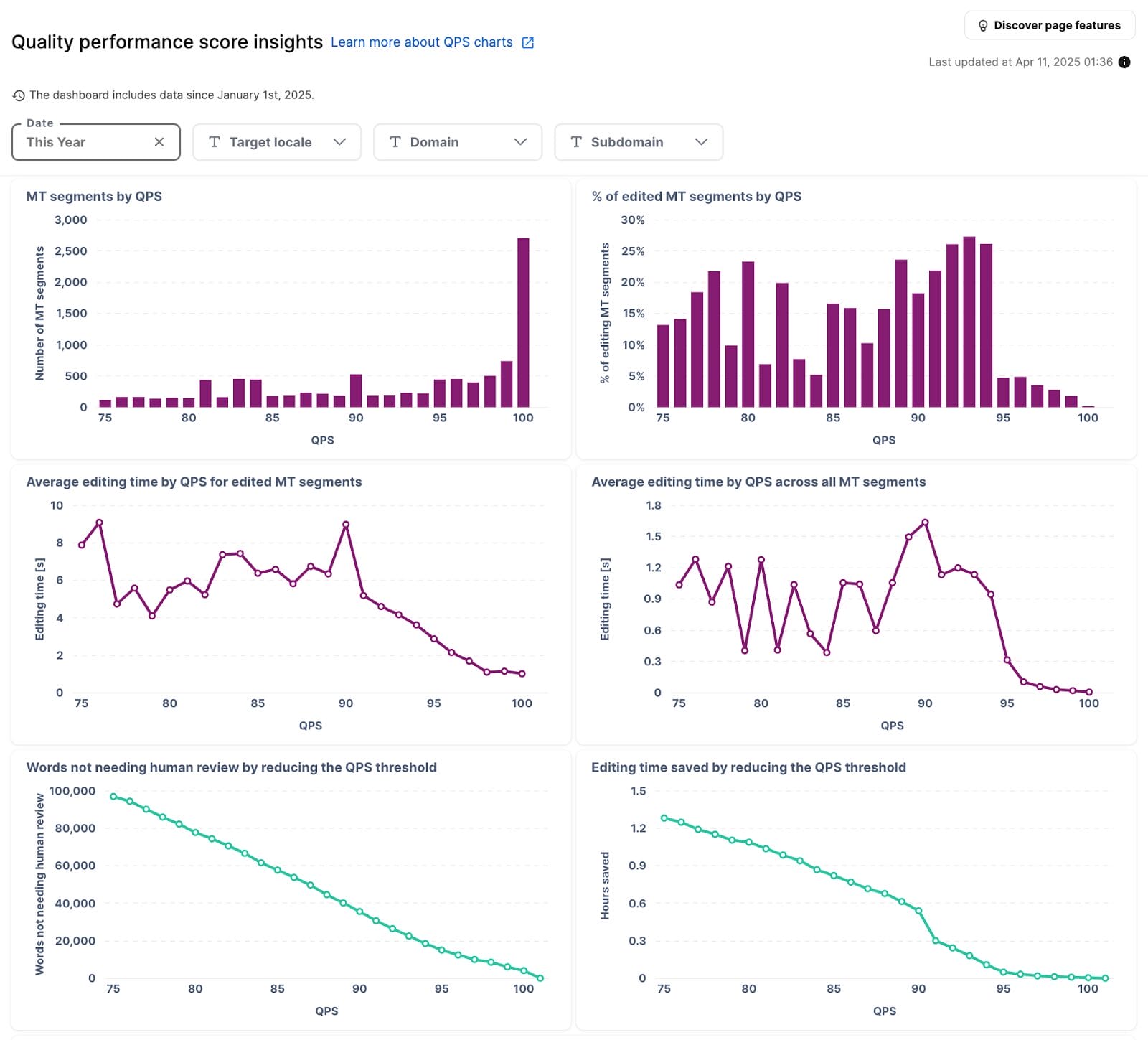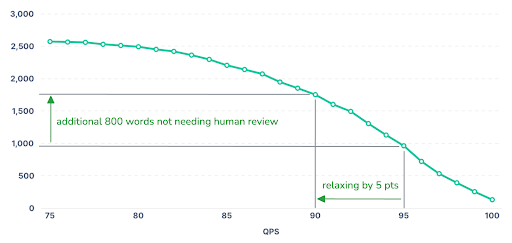Phrase TMS is a bit like a spaceship cockpit–full of buttons, sliders, and settings. While many of these have only a minor effect on your localization workflow, a few can seriously help you alter the course of the ship. These include the TM (Translation Memory) Threshold and. Phrase QPS (Phrase Quality Performance Score) Threshold.
These settings have a huge influence on what your pre-translation delivers and, in turn, how well you manage your Time, Cost, and Quality. If you want to level up your localization game, learning how to fine-tune these two “dials” is a must.
To make fine-tuning these settings easier (and eliminate the guesswork), the Phrase team has been digging into the data. Over the past few quarters, we’ve been tracking billions of data points tied to segment behavior, crunching the numbers, and turning those measurements into actionable insights.
The goal? To help you set the perfect TM and Phrase QPS Thresholds with confidence.
In the fall, we rolled out the TM Threshold dashboard along with smart recommendations.
At the beginning of April, we added a powerful upgrade that lets you slice the data by commonly used project metadata like Domain, Subdomain, and Target Locale. And just this March, we followed it up with the Phrase QPS Insights dashboard, your new co-pilot for finding the right balance between savings and risks.
The industry has taken a big step forward
And yes, it’s already making a difference.
Before we rolled out the TM Threshold initiative, that setting hadn’t budged in years. Most projects were stuck at an average threshold of 76 – low, and more importantly, completely flat.
Even as machine translation steadily improved, the “hand-off” point between TM and MT (Machine Translation) stayed the same. Loc teams kept leaning heavily on TM, even when MT could have delivered better results.
But now, with real data and guidance in place, we’re finally seeing that balance shift. For the first time, the average TM Threshold has crossed the 80 mark. It jumped a full 10 points, landing around 86.

That’s a huge improvement, but it’s just the beginning. The industry has taken a big step forward. Now, let’s not stop halfway. There’s still a lot of untapped potential in MT.
Why does this bother me? Because fuzzy matches always need human review. And if you’re relying on them, you can forget about fully automating your translations.
A TM can only serve up the translation of the most similar segment it’s seen, so you know it’s not a translation of your current segment.
Take this example: last week, your TM stored a translation for “The jury found the dependent guilty.” Today, a brand-new segment comes in: “The jury found the defendant not guilty.”
The fuzzy score will be high, but you absolutely want a linguist reviewing that. Otherwise, someone could end up doing time they don’t deserve.
TM Threshold as a thermometer for automation
Here’s the thing: MT doesn’t come with that baggage. It always produces a complete translation, every time. You can choose to have humans review it, but you don’t have to.
That’s what makes MT so powerful for automation. And that’s why your TM Threshold setting is more than just a number; it’s a reflection of your automation mindset. The higher it is, the more you’re leaning into automation.
I like to think of the TM Threshold as a thermometer for automation. If you’re hanging out in the 70s, it’s still pretty chilly. In the 80s? You’re warming up for the automation game. Hit the 90s, and now we’re talking. Anything above 95? That’s pro-level; you’re really letting MT do its thing.
So open up your TM Threshold in Analytics and see where MT outperforms TM fuzzies. Where MT saves you valuable editing time.

Phrase QPS Threshold
You can choose to have humans review MT output, but you don’t have to. This is exactly where the Phrase QPS Threshold comes in. Phrase QPS estimates the quality of MT at the segment level, helping decide which segments are good enough to be auto-confirmed. But more about that next time. In other words, it’s your smart filter for automation: catching low-quality translations before they slip through, and sparing your team from reviewing everything manually.
The tricky part? Figuring out where to set that threshold.
That’s why, in March, we introduced the Phrase QPS Insights dashboard; a new tool to help you find the sweet spot between cost savings and quality risk.

Step 1: Understand how MT quality affects human effort
Use the first 4 charts to explore how different Phrase QPS scores correlate with editing activity and effort.
See where your segments fall on the Phrase QPS scale, how often linguists step in to make changes, and how much time they actually spend doing it. This is your starting point for understanding when MT is doing its job.
- Chart 1 shows the distribution of segment volumes based on their Phrase QPS score.
- Chart 2 shows the percentage of segments that were edited by linguists. Higher Phrase QPS scores are expected to have fewer edits.
- Chart 3 shows how much time linguists spend editing segments.
- Chart 4 includes both edited and unedited segments (segments with 0 editing time). This provides a clearer picture of the overall effort spent on all processed segments, combining insights from the previous two charts.
Step 2: Explore the impact of lowering your Phrase QPS Threshold
See how adjusting the threshold can unlock automation and reduce manual work.
Charts 5 and 6 help you estimate the payoff of lowering your Phrase QPS threshold – more auto-confirmed words and less editing time.
- Chart 5 estimates the number of auto-confirmed words that won’t require human verification if the Phrase QPS threshold is lowered. For example, if the Phrase QPS threshold decreases from 95 to 90, the average number of auto-approved words may increase from 950 to 1,750.

- Chart 6 shows how much editing time could be saved if the Phrase QPS threshold is reduced.
Step 3. Track your automation progress over time
Measure how your strategy is paying off by watching the shift from edited to auto-confirmed MT segments.
Chart 5 helps you keep an eye on long-term trends. As you tweak your Phrase QPS threshold and improve your MT setup, you should see fewer edits and more segments flying through untouched. It’s your progress report for automation maturity.
Turning insights into actions
Mastering TM and Phrase QPS Thresholds is about moving from guesswork to informed decision-making. With segment-level insights at your fingertips, you can fine-tune where automation makes sense, where it saves time, and where it still needs a human touch.
Fine-tuning these settings helps reduce manual work, improve consistency, and scale more effectively. It’s a shift toward localization that’s faster, leaner, and based on evidence—not assumptions.
The tools are there. The data is clear. Now it’s about using them to work smarter, not harder.
Want to take it even further?
These insights are powered by segment-level metrics. With Phrase Data Premium, you get access to the raw, segment-level data behind it all.
That means fully custom insights tailored to your workflows, languages, domains, and teams. If you’re ready to make sharper, more strategic decisions, this is how you get there.





